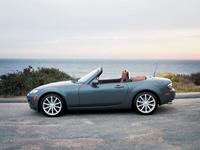| By: Brad Nevin | Ford
Communications Network |
The third-generation Mazda MX-5 Miata made its world
debut at the 2005 Salon International de l'Auto in Geneva.
GENEVA, March 1, 2005; The all-new Mazda MX-5 Miata made its world debut today at
the 2005 Salon International de l'Auto in Geneva. The new Miata goes on
sale late this year along with the all-new MAZDA5. Both vehicles are part
of Mazda's ongoing effort to overhaul its line of vehicles.
The unveiling of the third-generation Miata comes 16 years after Mazda
debuted the first-ever Miata at the Chicago Auto Show in 1989. In
describing the first Miata, automotive journalist Paul Eisenstein wrote:
"No one had ever really been able to capture the simple design and
fun-to-drive nature of classic British roadsters, like the Triumph Spitfire
or MGB. Mazda went the Brits one better, rolling out a nimble two-seater
that didn't need to spend half its life in the repair shop."
According to Mazda, the new model aims to evolve the lightweight roadster
concept even further.
"Our effort with the all-new MX-5 was to retain the key roadster attributes
that made this car famous -- the lightweight feeling, the balanced
handling, the overall nimbleness of the product -- but make the vehicle
more useful for a wider range of customers, offering better value and more
comfort, more interior space and overall higher levels of interior
quality," said Takao Kijima, program manager of the new vehicle.
Mazda engineers said they identified five requirements when designing the
new roadster:
- The car would be as compact and as light as possible while meeting
global safety requirements.
- The cockpit would comfortably accommodate two full-stature occupants.
- The rear-drive configuration would position the engine ahead of the
driver but behind the front axle for ideal 50:50 weight distribution.
- All four wheels would be attached by wishbone or multi-link suspension
systems to maximize tire performance, road grip and dynamic stability.
- And there would be a solid connection between the engine and
rear-mounted differential to sharpen throttle response.
 |
 |
|
Compared to the previous Miata,
overall dimensions are slightly larger: 0.8 inch longer, 1.6 inches wider,
0.8 inch higher and a 2.6 inch wheelbase increase.
"That extra width comes courtesy of a departure in styling for the little
roadster, which for the first time abandons its characteristic Coke-bottle
shape for a more RX-8-like design, complete with flatter flanks and bulbous
front fenders," wrote AutoWeek magazine in its preview story on the car.
"The additional space afforded by this move not only benefits passengers
with more hip and shoulder room, but also allows for the addition of
side-impact airbags."
On its skin, the new MX-5's nose and tail have similar proportions to the
previous Miata, but now the surfaces wrap smoothly between the wheels
without getting narrower at the bottom of the doors and bumpers.
With materials such as ultra-high-tension steel, Mazda says the MX-5's new
body is 22 percent stiffer and 47 percent less prone to torsional twisting
(bending of the frame when driving) compared to the previous model. The
engine has also been moved rearward by 5.3 inches to help achieve 50:50
front-to-rear weight distribution.
Two new engines power the new MX-5. Global markets get a 2.0-liter
four-cylinder engine while European markets get a 1.8-liter unit. While
final power ratings for each engine will be announced as the vehicles go on
sale, Mazda puts preliminary power estimates for the 1.8-liter at 124
horsepower at 6,500 rpm; tthe 2.0-liter European model is estimated to
achieve 156 horsepower at 6,700 rpm. (Engine output will differ depending
on local requirements.)
Mazda's newly-developed six-speed manual transmission will be available in
all markets. Depending on the market, the Miata will also be offered with
five-speed manual, or an advanced six-speed automatic, which can be
manually controlled by the shift lever and by steering-wheel-mounted
paddles.
Other changes include a two-volume
side-impact airbag positioned inside each seat backrest. An adjustable
steering wheel and more freedom for the seats to move both help tall or
short drivers find a comfortable fit in the cockpit. Curb weight increases
marginally by about 22 pounds.
After previewing the new Miata before the Geneva show began, Eisenstein
said that the new model is "light, simple and puts a premium on that
fun-to-drive element that roadster purists crave." He also said that he
expects "this latest update will breathe new fire into a brand that, 16
years after its introduction, has plenty of life left in it."






